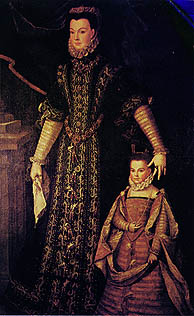
painted circa 1580
Collection Duc de Grammont
In this portrait, the Comtesse wears a black gown with a high-necked bodice, elaborately embroidered in gold down the front. The undersleeves are gold and white-striped, and the oversleeves hang down from the elbow. Many elements--in particular the color scheme and the shape and decoration of the bodice--echo the Portrait of Anne of Austria of a decade ago. The gown's black color is an example of the growing european predilection for black clothing in general.
The comtesse is accompanied, in this painting, by her small daughter. Children's clothing was as ornate and restrictive as that of their parents, as you can see. The child wears a square-necked bodice, spanish great-sleeves, and the same gold-and-white striped sleeves as her mother. These stripes are echoed by the striped pattern in the little girl's gown fabric.
Although young girls did not have to wear boned bodices, farthingale hoop skirts, chemises, petticoats, skirts, bodices, ruffs and headgear were all required dress for daughters of the nobility--even at age 5. Children were not only expected to wear such heavy clothing without complaint, but to keep it clean as well. Discipline for children was quite strict in Elizabethan times. It was considered a man's duty to beat his children if they misbehaved; young children, girls in particular, were to be quiet, meek, and well-behaved, on pain of punishment.